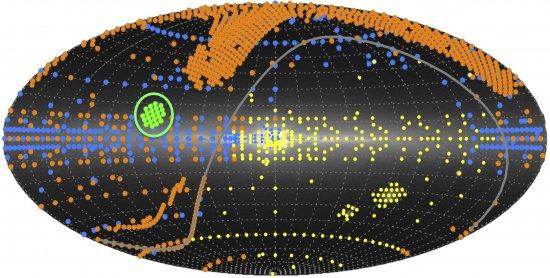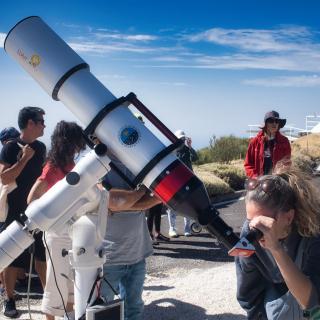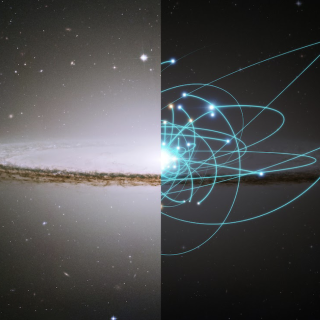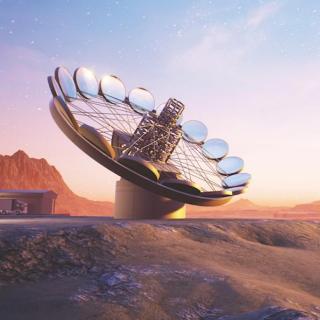On the basis of its previous successes the Sloan Digital Sky Survey, (SDSS) is launching a new programme which will extend its census of the universe to as yet unexplored regions. This project has three aims: the measurement of the chemical composition and the movements of stars throughout the whole of the Milky Way; the production of detailed maps of the internal structure of thousands of nearby galaxies to find out how they have grown and evolved during thousands of millions of years; and the measurement of the expansion of the universe during a time interval which goes back some eleven thousand million years, and of which we know very few details.
More than 200 astronomers from more than 40 institutions in four continents, including as the Spanish member the Instituto de Astrofísica de Canarias (IAC) will participate in this new programme. Using two purpose built telescopes each of 2.5m in aperture (which together give a field of view some ten times bigger than the angular area of the Moon), one in the USA at the Apache Point Observatory, and the other in Chile, at the Las Campanas Observatory, the SDSS will, for the first time, be able to observe any point in the sky.
“The SDSS project has revolutionized modern astronomy, by providing the most detailed maps until now of the structure of the universe on large scales, and of the stars which form our galaxy, the Milky Way”, states Ismael Pérez Fournon, Professor at the University of La Laguna and researcher at the IAC.
This new phase of the SDSS will yield a huge data base of observations which will enhance mark a major step forward in our understanding of the nature of the Universe on all scales, from our own galaxy to the distant universe. Carlos Allende Prieto, researcher at the IAC, who is directing the participation of the Institute in the SDSS project, can hardly hide his enthusiasm. “During the past 14 years, the SDSS has measured the distribution of light over the full range of colours – the spectra- of almost a million stars, creating the largest catalogue of this type for the Milky Way. Three years ago a new instrument was introduced into the project, which work in infrared light, which cannot be seen by the human eye, but which can be detected by specialized instruments and which allows us to measure the chemical composition of stars in regions which are hidden from us by interstellar dust. Here at the IAC we are responsible for the software used to analyse the data. In the new phase we will be able to take observations from the southern hemisphere also, in order to observe regions of great interest which cannot be observed from the north.
The observations carried out in this new phase will complete the global image of the universe given by the SDSS project. As well as covering the full 360 degrees required to observe our galaxy the SDSS will also be able to measure thousands of stars in the small neighbouring galaxies, the Magellanic Clouds, which can be seen only from the southern hemisphere. The new program will discover a large number of cosmic objects with exceptional properties, both stars and galaxies, providing new scientific opportunities to Gran Telescopio Canarias (GTC), given the exceptional capability of this telescope for very detailed studies.
However, the Milky Way the the Magellanic Clouds are not the only galaxies which the new SDSS will be surveying. The project will use novel technologies to analyse thousands of nearby galaxies in great detail. Using compact bundles of optical fibres, the new SDSS will obtain maps of the velocities, the chemical composition, and the ages of the stars in more than 10,000 nearby galaxies. “With its new equipment, the SDSS will give us detailed maps of a large sample of galaxies, fifteen times as many as the sample we have today. These maps will help us to understand how the galaxies form and evolve, and why some are very different from others” comments Jesús Falcón Barroso, an IAC researcher who is an expert in galaxies.
The new SDSS will also continue to provide measurements of the expansion of the universe, reaching back to 80% of cosmic history, from the present time, at some 14.000 million years alter the Big Bang, to the epoch at which the universe was only 3,000 million years old. The new data will help us to try to understand the nature of the “dark energy”. The best estimates suggest that this mysterious energy, which causes the whole universe to accelerate, accounts for some 70% of all the energy, and therefore all the mass, of the universe. "The new SDSS -explains José Alberto Rubiño, IAC researcher- focus its efforts on observing galaxies and quasars in a range of distances that has remained completely unexplored by other surveys, providing valuable information not only on the global and dynamical properties of our universe, but also the physical properties of its constituents. In particular, it will allow astronomers to put constraints on neutrino masses (with a much better precision than that obtained with experiments from Earth). "
Other programmes within the Framework of the new SDSS will study variable objects, and galaxies previously observed with X-ray satellites.
Contacts:
Carlos Allende Prieto, callende [at] iac.es (callende[at]iac[dot]es), 922 605 421
Jesús Falcón Barroso, jfalcon [at] iac.es (jfalcon[at]iac[dot]es), 922 605 503
Ismael Pérez Fournon, ipf [at] iac.es (ipf[at]iac[dot]es), 922 605 257
SDSS website: www.sdss.org
See also SDSS projects:
- APOGEE-2: http://www.sdss.org/sdss-surveys/apogee-2/
- eBOSS: http://www.sdss.org/sdss-surveys/eboss/
- MaNGA: http://www.sdss.org/sdss-surveys/manga/
- Prior SDSS surveys: http://www.sdss.org/sdss-surveys/#ongoing



